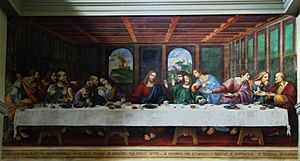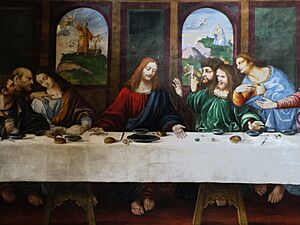Ponte Capriasca facts for kids
Quick facts for kids
Ponte Capriasca
|
||
|---|---|---|
|
||
| Country | Switzerland | |
| Canton | Ticino | |
| District | Lugano | |
| Area | ||
| • Total | 6.17 km2 (2.38 sq mi) | |
| Elevation | 447 m (1,467 ft) | |
| Population
(Dec 2020 )
|
||
| • Total | 1,871 | |
| • Density | 303.2/km2 (785.4/sq mi) | |
| Postal code |
6946
|
|
| Surrounded by | Cadenazzo, Capriasca, Cavargna (IT-CO), Isone, Lugaggia, Medeglia, Origlio, Sant'Antonio, Sigirino, Torricella-Taverne, Valcolla | |
Ponte Capriasca is a small town, also called a municipality, in Switzerland. It is located in the Ticino region, which is a canton (like a state or province). The town is part of the Lugano district.
Contents
History of Ponte Capriasca
Early Mentions and Independence
Ponte Capriasca was first written about in the year 1335. Back then, it was just called Ponte. Later, in 1491, it was known as Ponte Criviascha.
For a long time, Ponte Capriasca was part of the Lugano area. This area was once ruled by the Duchy of Milan. Later, it came under the control of the Swiss Confederation. Even during these times, the village was quite independent. It had its own rules and rights. These rules were first written down in 1443 and confirmed again in 1648. In the early 1500s, the village saw some intense fights. These were between two rival groups called the Guelphs and Ghibellines.
The Church of S. Ambrogio
In 1455, Ponte Capriasca became its own parish. This meant it had its own church and religious community, separate from Tesserete. The main church, S. Ambrogio, was first mentioned in 1356. However, it was built on much older foundations from the Roman era.
The church you see today was mostly rebuilt in 1835. Parts of the old bell tower and the main hall were kept. Inside the church, there is a famous painting called The Last Supper. This painting was made in the 1500s. It was inspired by Leonardo da Vinci's famous Last Supper painting. The painting has been carefully cleaned and fixed up twice, in 1951 and again from 1989 to 1992.
Economic Changes and Growth
For many years, the people of Ponte Capriasca mostly worked in farming. They also earned money from seasonal migration. This meant people would travel to places like northern Italy for work during certain times of the year.
Starting in the 1970s, the village grew very quickly. Many new buildings were constructed. The number of people living there increased five times! By 2005, more than half of the jobs in the town were in the service industry. This means jobs like shops, restaurants, and other services. Also, over three-quarters of the people living in Ponte Capriasca traveled to other places for work. These people are called commuters.
Geography and Landscape
Ponte Capriasca covers an area of about 6.2 square kilometers (2.4 square miles). A large part of this land is covered by forests. About 64% of the area is forested. This means there are many trees and natural areas.
About 8.2% of the land is used for farming. This includes fields for growing crops and pastures for animals. Around 8.7% of the town's area has buildings or roads. This is where people live and move around. A small part, about 0.3%, is made up of rivers or lakes. The rest of the land, about 13.1%, is not used for farming or buildings. This might be rocky areas or places with wild plants.
The town is located in the Lugano district. It is part of the Valli di Lugano Region, which means the Valleys of Lugano.
Town Symbol: The Coat of Arms
The official symbol of Ponte Capriasca is its coat of arms. It shows two male goats standing on a bridge. The background is split into red and white sections. The goats and the bridge are colored in a way that they switch colors depending on the background.
The word for male goat in Italian is capri. This is why the goats are on the coat of arms. It's a clever way to include part of the town's name, Capriasca, in its symbol. This type of symbol is called a canting arm.
Population and People
Ponte Capriasca has a population of about 1,700 people. As of 2008, about 12.6% of the people living there were foreign nationals. Over ten years, from 1997 to 2007, the population grew by about 13.4%.
Languages Spoken
Most people in Ponte Capriasca speak Italian. About 81.3% of the population speaks Italian. The second most common language is German, spoken by about 13.4% of the people. A smaller number, about 2.2%, speak French.
Age Groups
Looking at the age of the people in Ponte Capriasca (as of 2009):
- About 12.6% of the population are children aged 0 to 9 years old.
- Another 12.3% are teenagers, aged 10 to 19.
- Adults aged 20 to 59 make up about 53% of the population.
- People aged 60 and older make up about 22.2% of the population.
Homes and Housing
In 2000, there were 594 private homes in Ponte Capriasca. On average, about 2.5 people lived in each home. Most of the buildings were single-family homes. About 79.6% of the apartments in the town were lived in all the time. About 20.2% were used for holidays or only at certain times of the year.
Population Growth Over Time
The chart below shows how the population of Ponte Capriasca has changed over many years. You can see how the number of people living in the town has grown or shrunk at different times.

Important Heritage Site
The Parish Church of S. Ambrogio is a very important building in Switzerland. It is listed as a heritage site of national significance. This means it is a special place that is protected because of its history and cultural value.
Economy and Work
In 2007, the unemployment rate in Ponte Capriasca was about 3.18%. This means a small number of people who wanted to work could not find jobs.
Types of Jobs
In 2005, people in Ponte Capriasca worked in different types of jobs:
- Primary Sector: About 11 people worked in this sector. This includes jobs like farming and forestry.
- Secondary Sector: About 131 people worked in this sector. This includes jobs in factories and construction.
- Tertiary Sector: About 144 people worked in this sector. This includes jobs in services, like shops, offices, and healthcare.
In total, 743 people living in the town had jobs. About 40.9% of these workers were women.
Commuting for Work
Many people who live in Ponte Capriasca travel to other towns for work. In 2000, 588 people left the town to work elsewhere. Only 159 people came into Ponte Capriasca to work. This means more people leave the town for work than come into it. Most people, about 70.3%, used a private car to get to work. About 9% used public transportation.
Religion
According to a census in 2000, most people in Ponte Capriasca are Roman Catholic. About 74.1% of the population belonged to the Roman Catholic Church. Another 12.6% belonged to the Swiss Reformed Church. Some people belonged to other churches, and a small number did not state their religion.
Education
Ponte Capriasca has a good education system. About 82% of adults (aged 25 to 64) have finished either high school or gone on to higher education, like university.
Schools in Ponte Capriasca
In 2009, there were 340 students in Ponte Capriasca. The education system in Ticino, the canton where Ponte Capriasca is, offers different levels of schooling:
- Kindergarten: Children can attend up to three years of non-mandatory kindergarten. In 2009, 51 children were in kindergarten.
- Primary School: This program lasts for five years. In Ponte Capriasca, 122 students attended standard primary schools.
- Lower Secondary School: After primary school, students can choose different paths. Some go to a two-year middle school. Others go to a four-year program to prepare for university.
- Upper Secondary School: This level prepares students for a job or for university. Students might do an internship or apprenticeship while studying.
- Professional Programs: These programs last three years. They prepare students for specific jobs in fields like engineering or nursing.
Many students from Ponte Capriasca also attend schools in other towns. In 2000, 144 residents went to schools outside the municipality.
See also
 In Spanish: Ponte Capriasca para niños
In Spanish: Ponte Capriasca para niños







